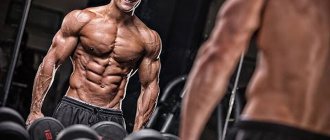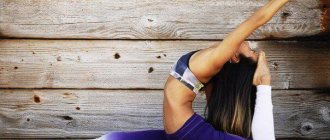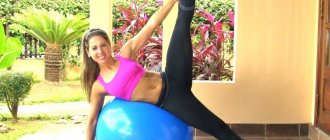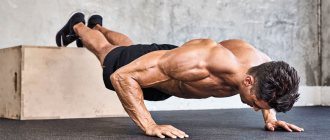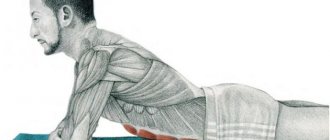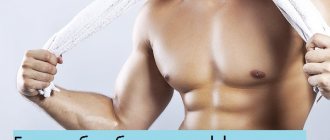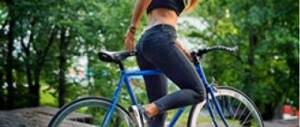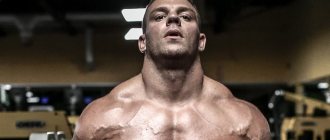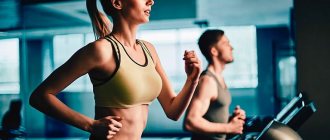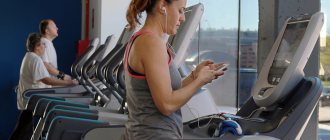Both women and men dream of having toned abs. There are many different ways and devices to make this dream come true. One of them is an ab roller, which is a small wheel with handles on both sides. Before purchasing a gymnastics wheel, it is worth analyzing the various offers on the market.
It is equally important to correctly assess your own capabilities. Then all that remains is to purchase a roller and select suitable abdominal exercises with a wheel. The best option is to take classes from an experienced instructor. Such a competent approach will allow you to correctly and quickly pump up your abs with a roller and become the owner of an elastic stomach.
Types of ab rollers
The abdominal exercise wheel has a simple design. This type of exercise machine is a comfortable handle, divided by a wheel into right and left halves exactly in the middle. Thanks to this design, holding the gymnastic roller in your hands is very comfortable.
It is worth noting that the apparent simplicity of this device does not mean low efficiency and lack of benefit for the athlete. By choosing the right gymnastic wheel along with a set of exercises, you will be able to perfectly strengthen your triceps and pump up your back and abdominal muscles.
The fitness wheel is available in a wide variety of models, the most popular of which are presented in the following table:
| Model name | a brief description of |
| One- and two-wheeled | Sports wheel with one or two circles. The second circle makes it easier to master any exercise, since when working with the wheel you no longer have to maintain balance on your own. |
| With return mechanism | A special sports exercise machine with a wheel and a return mechanism helps eliminate muscle overload, reducing tension on the lumbar spine. And therefore, working on such a video will be very useful for beginners. |
| Trimmer with tensioners | In this case, a trimmer is a design of a simulator in the form of a double wheel with a flexible attached cable. When working with such a gymnastic apparatus, the main emphasis falls on the abs and lower limbs, since the back part of the cable is attached to the legs. |
| With pedals | A sports wheel with handles and pedals helps to pump up the abs and develop the muscles of the lower extremities. |
| With a shifted center of gravity | An original sports equipment with a shifted center of gravity is simply ideal for experienced athletes. This abdominal wheel is characterized by an increased level of difficulty and also requires effort during the exercise. |
In addition to choosing the right wheel for working out the abs, you will also need a special training program, which should be developed by an experienced instructor. Only a competent coach will be able to correctly assess the student’s level of physical fitness and identify the level of his capabilities and needs.
What are the benefits of roller skating?
If you start roller skating to help your health, you can notice the effect within about 2-3 months. Moreover, in the future the results from the classes will increase. In order to get all the beneficial properties from training and avoid harm, it is best to exercise on embankments or in green areas, on specially designated paths or smooth paths in the park. First of all, being in the fresh air will benefit you.
As you know, movement is life.
- Thanks to leisurely walks, the functioning of the heart and the entire cardiovascular system is normalized. The vessels come to the required tone.
- The legs, lower back, buttocks, hips and ankles are strengthened.
- Thanks to the need to control balance and balance, the properties of the vestibular apparatus are trained and coordination is improved.
- In addition, the happiness hormone endorphin is released, which helps lift your mood.
Thus, roller skating benefits all fans of this type of sports activity. These skills can also be trained during bicycle rides, but in a city apartment there is not always space to accommodate bicycles, and roller skates do not require much space. No less important is the use of roller training against excess weight.
Working out muscle groups
Despite its apparent simplicity, a gymnastic roller helps to work out a significant number of muscle groups. To do this, you don’t need to subject yourself to heavy training, just choose 6 or 8 exercises that will increase the stretching of different muscle groups and also increase endurance with strength.
But you need to do exercises with the abdominal wheel correctly, and also repeat them a certain number of times. During the training process, various muscle groups are worked out. First of all, the following departments are involved in the work:
- Back. During the execution, the gymnastics wheel puts a colossal load on the muscular corset of the back. Basically, the latissimus and lumbar muscles are involved.
- Breast. Proper training with the wheel also helps strengthen the muscular corset of the chest, although to a slightly lesser extent than the muscles of the back.
- Shoulders. As you perform the exercises, the gymnastic wheel allows you to load your shoulders, which become stronger after several sessions.
- Stomach. Thanks to the roller, the oblique muscles are strengthened, which “work” intensively when performing exercises with body flexion and extension.
- Legs and buttocks. In this case, the muscles of the legs and thighs, which usually bear static loads, are most involved.
- Neck and arms. If you pump your abs correctly using a roller, you will be able to put stress on the muscles of your arms and neck.
In addition to all of the above, exercises for the wheel help to work out skeletal muscles, strengthen joints and the spinal column. Thanks to such a complete workout, you will be able to pump up the muscle corset of the whole body. Especially in those cases if you pump the press with the wheel correctly.
What muscles work when training with a roller?
- Back. This is where the main load falls. The lumbar, latissimus, and trapezius muscles work. The most effort is exerted when keeping the body in a straight position.
- Breast. Practically does not work, plays the role of a stabilizer.
- Shoulder girdle. Due to the need for constant movement of the gymnastic roller, the shoulders are constantly working. The number of back and forth approaches that will be performed depends on their preparation.
- Stomach. The rectus and oblique muscles (abs) work. During bending and stretching of the body, the lateral muscles also work, maintaining the balance of the body and stabilizing the body at the main points.
- Buttocks, thighs. The gluteals work harder than the rest, as they extend and flex during the load on the hip joints. The shins and thighs are involved only statically.
- Hands. They are responsible for capturing the projectile, its position, direction, movement. The forearms, biceps, and triceps work (depending on the position of the hands).
Note! In addition to muscles, joints also work. The maximum possible load depends on their strength and endurance. If the joints are unprepared, it is recommended to use special clamps or elastic bandages.
In addition to visible muscle groups, skeletal muscles are actively involved in training. Regular abdominal exercises with a roller will strengthen the musculoskeletal system and improve its activity.
Safety regulations
Most beginners often think that practicing with a roller is very simple. But in fact, this simulator requires a lot of effort from the practitioner and compliance with the following safety rules:
- When working with a wheel, you should not allow the body to sag, nor should you allow your knees to touch the floor surface;
- exercise the abdominal wheel correctly - perform slow rolls;
- during training, you need to keep your back and arms and legs straight and try to pump your abs with the wheel as correctly as possible, without bending;
- When performing the plank and working with other exercises, you must carefully ensure that the movements are carried out using the wheel and not a mat placed under it;
- it is necessary to concentrate on the abdominal muscles and stop training when pain occurs.
If you do not follow the listed rules and perform abdominal roller exercises incorrectly, there is a high probability of injury.
It is also necessary to take into account that the presence of an intervertebral hernia and other back problems is a contraindication for working with a roller, so it is worth consulting with a doctor about the possibility of such exercises.
The benefits and harms of roller skating for children
Roller skating brings great benefits to a child's body. If you take into account all the recommendations, harm is excluded.
So, the beneficial properties of roller skating:
- Strengthening the buttocks and legs.
It should be noted that those muscles are used that cannot be worked in other types of physical activity. Attention! This benefit of roller skates is also relevant for many girls who are concerned about the condition of these parts of the body. - Since the baby needs to maintain balance when skating, the back, stomach, and shoulder girdle are trained in the process.
- Coordination improves. Thanks to this, the child’s gait changes, it becomes lighter and more graceful.
- Roller skating helps train the cardiovascular system, making it more resilient.
- In the process of skating, a large number of calories are burned without additional harm, which allows the child to maintain a slim and fit body.
- The baby’s visual apparatus is trained, since during the ride the child is forced to look either into the distance or around him.
- Physical activity is good for the nervous system because it relieves tension.
- Roller skating has overall health benefits because physical activity in the fresh air helps oxygenate the blood, which hardens and strengthens the child's body.
Features of working with the wheel for beginners
A variety of exercises with a wheel will help to work out the abs and muscles of the body, but only with a competent approach to the training process, in compliance with the technique of performing the exercises.
That is why when working with a video for beginners you need to adhere to the following list of recommendations:
- You should start your workout with a good warm-up. Since wheel exercises are quite intense, warming up is always necessary.
- Number of classes. If you have no experience working with a roller, practice 1-2 times a week. Then you can attend training up to five times or more. The same applies to repetitions of any exercises with a roller.
- Doing exercises. Regardless of the type of exercise, you must try to perform it smoothly, measuredly and without jerking. It is also very important to take your time, since speed is not needed in this case.
- The end of the workout should be completed with stretching. It will further warm up the muscles and eliminate the risk of lactic acid accumulation.
Roller exercises for weight loss
As mentioned above, even regular roller skating is beneficial for those who want to lose weight. But if you do some exercises, you will lose weight much faster, since energy consumption will be higher:
- "Hourglass". With this exercise you will be able to tone the muscles of the inner thigh. As you know, this is one of those areas that is most difficult to work on. To perform this exercise, you will need to move forward or backward, while periodically bringing your legs together and spreading them.
- "Snake". The legs should be parallel and slightly bent at the knees; when moving forward, the body should be tilted to the right and left alternately. The movement should be wave-like. The exercise helps work the hips and ankles.
- "Wave". This exercise is similar to the previous one, only one leg should be placed behind the other.
- Riding on an incline. Excellent results can be obtained when driving uphill. The exercise strengthens the abs, while the stabilizer muscles responsible for retracting the abdomen work.
How to choose the right ab roller
You should also take the issue of choosing a video seriously. It should fit the weight, allow movement without jerking, and support the body. It is best to start with a roller with a double or wide and rubberized wheel.
When purchasing a gymnastic roller, it is very important to correctly assess your own capabilities and level of physical fitness. For beginners, a simulator with a light weight and a return mechanism is best suited, and for experienced athletes - with pedals.
A wide variety of models will allow you to choose the most suitable option for anyone. The main thing is to adhere to basic safety rules and try to select exercises with the roller wisely.
Exercises for Beginners
Several types of exercises are offered for each level. You should start with a minimal load so that the body gets used to exercises, compressions, stretches, and control of the roller.
From the knees to half the amplitude
It is the simplest exercise for beginners that can be performed even at home. It will allow you to get to know the video better and learn the control features.
- You need to kneel, the distance between your legs is approximately 15-20 cm.
- Take the simulator in your hands and place it on outstretched arms on the floor. Lock into position for stability.
- As you inhale, begin to roll your body along with the exercise machine, while it will gradually stretch. The maximum point will be considered the moment when the body is half stretched without touching the floor.
- After a few seconds of pause, pull the roller and body to the starting position. Movements are made while exhaling.
The number of approaches and rolls depends solely on the individual training schedule in the fitness club.
Advice! If the roller is not rubberized, you need to perform the exercise on a non-slip surface. In addition, it is recommended to place a gymnastics mat under your knees for comfort.
From the knees to the full amplitude
It differs from the previous version in that you need to stretch the body not to the middle, but to the maximum. At the same time, at the final point you need to stretch to the limit, while not touching the floor with your body. The back is straight, the muscles are tense. At the end point, pause for a few seconds.
Clothing and protection for roller skating
When choosing clothes for roller skating, you should focus on the basic rule: it should be loose and fairly durable. Rollerbladers often prefer jeans because they suffer less from contact with the asphalt surface. It is better to purchase special sports socks: they absorb moisture better and save your feet from chafing.
Don't neglect your helmet and elbow and knee pads. Beginners do not always manage to fall correctly, and protection will save the joints from injury. In addition, you can pay attention to special shorts, you can find them in sports stores: they have protective inserts in the tailbone and lower back. In this outfit you won’t be afraid to master skating.
For whom roller skating is contraindicated?
- If you have diseases of the vestibular system, you should not stand on roller skates. People with this disease have poor balance and fall constantly.
- If you have had a head injury, you should forget about roller skating for at least two months.
- If you have vision problems, you will definitely need contact lenses. The speed when moving is quite high, you need to have time to navigate: glasses can easily break and injure your face and eyes.
- If a person has flat feet, it is necessary to use special insoles-instep supports, only in this way the properties of the training will be beneficial, and the person will not suffer harm from the exercises.
